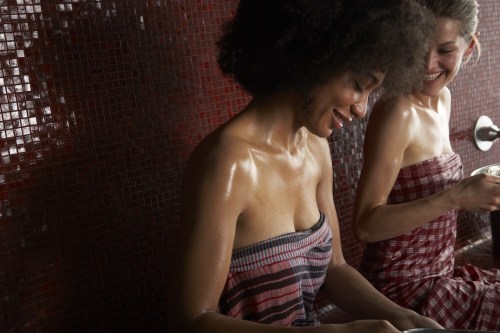Meet the 3-part Moroccan shower equation—aka the secret to your smoothest skin ever
Beauty editor Zoe Weiner traveled to Morocco and came home with the knowledge of how to practice a self exfoliating hammam session.

I’ve always considered washing my body to be a fairly dull act. Lather, rinse, and…that’s it. It doesn’t even require a “repeat” step the way washing your hair does. But on a recent trip to Morocco with Around the World Beauty, I had the chance to visit a traditional Hammam, and my perception of what it means to take care of my body skin was forever changed.
A quick history lesson on Hammams: The traditional baths have been an integral part of Moroccan culture for centuries, and date back to the Roman and Ottoman Empires. They began as public bathhouses where women could go to get professionally cleansed and scrubbed (keep in mind this was long before most people had baths or showers in their homes), and morphed into cultural epicenters—particularly for women. Moroccan women would go to the bathhouses to catch up and share ideas, and would leave with their skin feeling silky smooth.
While the cultural significance of the Hammam may have changed (case in point: you can now partake in the traditional treatments in private at luxury spas), the beauty practices have remained steadfastly the same. The treatment utilizes three ingredients indigenous to Morocco—black soap, Rhassoul clay, and argan oil—as well as a special type of exfoliating mitt to slough off every dead skin cell on your body.
“The benefits of the hammam include cleansing and detoxification, improved circulation, exfoliation and moisturization,” says Katharine L’Heureux, who uses many elements of traditional Moroccan beauty in her line, Kahina Giving Beauty. “Essential oils of orange blossom, eucalyptus and rose are very calming to skin and to the nervous system. Olive oil and argan oil featured in the soap are incredibly nourishing and skin softening. Rhassoul clay will often be used in shampooing because it’s wonderful for cleansing and detoxifying. These ingredients, even if you are replicating the ritual at home, will really help the skin, body and mind.”
This Parisian Skincare Brand Is Launching in the United States for the First Time—Here’s What a Derm Wants You to Know

We’re Calling It: Cleansing Balms Are the Face Wash of the Future—Here Are 3 to Add to Your Cart

This Is the One Product That Scarlett Johansson Always Keeps in Her Purse and on Her Bedside Table

On my morning at the Hammam at the Es Saadi Resort, I stripped down to nothing more than a pair of paper undies, and entered a steam room where an attendant rubbed Moroccan black soap all over my body. I laid on a stone slab for a half of an hour while the steam helped open up my pores, allowing the soap’s ingredients to penetrate more deeply. Then, it was time for a scrub with something called a Kessa mit, which is a roughly textured glove that the attendant used to exfoliate my body. It was so effective, I was actually grossed out by how much dead skin was pilling off of my own body. My New York City shower has at least 10 different scrubs lining its walls, and I had truly never seen a single one of them work this type of magic.
Next, came another level of detoxification by way of Rhassoul clay mask, which comes from the mid-Atlas mountains and is a favorite among Berber women, followed by another scrub with a Kessa mit (just when I thought there couldn’t be more dead skin on my body, there it was!). And finally, I received a full body massage with argan oil. When it was over, not only was I so relaxed I was tempted to cancel my entire day of touring Marrakesh in lieu of a nap, but my skin felt so smooth it was as if it had been manufactured in some sort of a smooth skin lab. I couldn’t stop touching it—I truly didn’t know how soft skin could be until I walked out of that Hammam.
http://www.instagram.com/p/Bwebsr_HUsJ/
Once I had experienced that level of skin softness, I couldn’t just go back to the “soft adjacent” status I had until then been accustomed to. And sadly, transporting a Hammam into my tiny NYC bathroom isn’t exactly the most realistic idea I’ve ever had. But as L’Heureux mentioned, there are ways to replicate elements of the Hammam at home without having to hire a professional to scrub your skin for you. And since my trip, I’ve done exactly that on a regular basis.
I start by cleansing my skin with the black soap (if you don’t have the luxury to sit with it in a steam room for 20 to 30 minutes, don’t worry—it will still get the job done), then use a Kessa Glove (which you can buy for $9 on Amazon) to get down and dirty with your dead skin. Next, coat your skin in a layer of Rhassoul clay, do some more scrubbing, and treat yourself to an argan oil massage. Then, feel free to spend the rest of your day literally feeling yourself, the way I now do on a very regular basis FWIW: L’Heureux recommends only doing the full scrubbing process once a week, but you can use the black soap and argan oil as frequently as your heart desires. Which in my case…is often.
In addition to treating dull, dead skin, Moroccan women also know the secret for dealing with dry skin, too. Plus, these are our favorite skin-care brands from all over the world.
Sign Up for Our Daily Newsletter
Get all the latest in wellness, trends, food, fitness, beauty, and more delivered right to your inbox.
Got it, you've been added to our email list.







